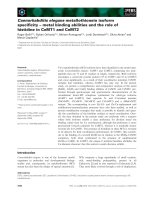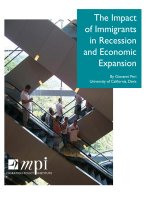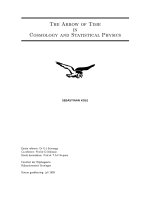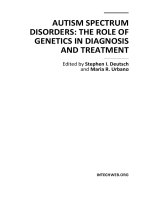The issues of modality in semantics and pragmatics
Bạn đang xem bản rút gọn của tài liệu. Xem và tải ngay bản đầy đủ của tài liệu tại đây (243.67 KB, 3 trang )
<span class='text_page_counter'>(1)</span><div class='page_container' data-page=1>
<b>z </b>
<i><b>Full Length Review Paper </b></i>
<b>THE ISSUES OF MODALITY IN SEMANTICS AND PRAGMATICS </b>
<b>*</b>
<b>Ho Van Han, M.A </b>
<b>The Faculty of Foreign Language, Ba Ria-Vung Tau University, Vietnam </b>
<b> *Corresponding Author </b>
<b>Received 26th August 2015; Published 30th September 2015 </b>
<b>Abstract </b>
To know the crucial of the semantic structure of human language, as well as the use of modality, this paper focuses on some
linguists’ views of the meaning of modality such as Coates (1983) and Palmer (1986) proposed and then suggests considering a
research of the use of modality in a context-free and a context-dependent based on the features of the specific language being
studied (English) to teach modality better for students who aim to study English as second language.
<b>Keywords:</b><i> Modality, Epistemic, Deontic </i>
<i><b>Copyright © Ho Van Han.</b><b> This is an open access article distributed under the Creative Commons Attribution License, which permits unrestricted use, distribution, </b></i>
<i>and reproduction in any medium, provided the original work is properly cited. </i>
<i><b>To cite this paper: Ho Van Han, M.A. 2015. The issues of modality in semantics and pragmatics, International Journal of Information Research </b></i>
<i>and Review. Vol. 2, Issue, 09, pp.1195-1197, September, 2015. </i>
<b>INTRODUCTION </b>
There are many different views about modality from the
perspective of word meaning, sentence meaning to utterance
meaning of the speaker. For instance, Coates (1983) named
root modality and epistemic modality, Palmer (1986) called
deontic and epistemic modality, etc. In fact, in the complexity
of modality, many linguists often grouped the meaning of
modality into their own concept, but they didn’t generalize all
meaning of modality because the term of modality is to broad
and complex. A linguist stated “comparing the relevant
grammars and the monographs to […] modal aspects in
general, one is astonished to find that in seemingly no other
field of grammar so much disagreement prevails as in what I
summarize under the term of modality. It is the true sense of
the world a maze in which every grammarian is searching for
his way.” Or, other interesting saying of Perkins (1983) “doing
research on modality is very similar to trying to move in an
overcrowded room without treading on anyone else’s feet.”
Because of complexity of modality, both native speakers and
other advanced learners of English use modality incorrectly.
They usually focus on grammatical characteristics without
noticing the subtle different meanings of each modality namely
modal verbs. They ignore the semantics and pragmatics of
modal verbs. They may use grammar of modality correctly, but
it is not proper in the situation. For instance, Altman (1982)
cited in Phong Tran Ky (2014) said “I began to look at the
acquisition of expressions of modality when I noticed that even
very advanced learners of English were using modals
incorrectly. I was driving somewhere with a friend – a native
Spanish speaker who speak English almost perfectly. We were
looking for a certain address, following the numbers on the
street, and just where we would have expected the place to be,
<i>we came upon a driveway and my friend said “That should be </i>
<i>the place.” Considering the circumstances, I was much more </i>
convinced that was in fact the place and would have left a lot
<i>more comfortable had she said “That must be the place.” </i>
In semantics implies that if Speaker 1 and Speaker 2 are having
a conversation, there will be certain information that must be
shared between them. It means that the intersection of the two
sets of knowledge lies what they both know. Both Speaker 1
and Speaker 2 believe they know what the other knows based
on the surrounding environment, or the information from any
prior interactions that they may have had, as well as all of the
information that everyone knows, like the norms of their
society. For example, dynamic modality interprets an utterance
based on the potential of that utterance to update the context of
the hearer, but epistemic modality interprets an utterance based
on what the speaker knows and he assumes that the hearer also
knows,.
Since the variety of modality has been told, the author only
focuses on the notions of epistemic modality and deontic
modality through the views of semantics and pragmatics.
According to pragmatics, language should be interpreted in
relation to the social context that the speaker uses it. On the
other hand, language should not be analyzed in an isolated way
of either symbols or mental rules, but in a specific context and
a specific communicative purpose.
<b>ISSN: 2349-9141 </b>
<i><b> Available online at </b></i>
<i><b>International Journal of Information Research and Review </b></i>
<i><b>Vol. 2, Issue, 09, pp.1195-1197, September,</b><b> 2015 </b></i>
</div>
<span class='text_page_counter'>(2)</span><div class='page_container' data-page=2>
<b>Modality distinction </b>
Modality is an expression of possibility or necessity or
anything in between. In linguistic understanding of modality,
there are two different notions; epistemic versus deontic
modality. Epistemic modality does with possibility or necessity
of the truth of propositions, and is thus involved with
knowledge and belief whereas, deontic modality is concerned
with the possibility or necessity of acts performed by morally
responsible agents, and is thus associated with the social
functions of permission and obligation Lyons (1977). Modality
has a variety of forces including, but not limited to, certainty
(must), likelihood (should), possibility or low probability
(might), etc. When a speaker uses an epistemic modal
<i>statement such as “It must be fine tomorrow”, the speaker </i>
states that according to his epistemic modality, or what he
knows, it is a certainty that it is fine. But insofar as the
<i>statement “It must be fine tomorrow” signals that it is made </i>
based on what the speaker believes only, it can actually be a
<i>weaker statement than “It should be fine tomorrow”. This is </i>
because in degree of the speaker’s commitment to the truth of
the proposition contained in the modal.
Epistemic modality is used with a bigger meaning, beside of
the meaning of possibility or necessity, it is also associated
with the degree of a speaker’s commitment to the truth of a
proposition contained in an utterance. Therefore, epistemic
modality has a subjectivity of the speaker because all evidences
or predictions that the speaker says are aim to g ive the degree
of a speaker’s commitment. Palmer (1986) defines modality
like a grammatical category based on speaker’s attitudes and
opinions that are determined cross-linguistically by semantics
and pragmatics.
Followings are some examples of the degree of a speaker’s
commitment.
<i> Tom can buy a new house next month. </i>
<i> Perhaps Tom buys a new house next month. </i>
<i> Tom’s buying a new house next month is possible. </i>
<i> It is possible that Tom buys a new house next month. </i>
<i> Tom might buy a new house next month. </i>
<i> Tom must buy a new house next month. </i>
<i> When Tom gets enough money, he will buy a new house. </i>
These statements above, the speaker’s subjectivity can be
expressed by his personal evidentiality or judgment to commit
the degree of evaluation of what he says.
So, if he does not assume the truth of what he said, epistemic
modality will be expressed by non-factuality.
According to Palmer (1986), there are at least four ways in
which a speaker can indicate that he does not present what he is
saying as a fact:
that he is speculating about it
that he is presenting it as a deduction
that he has been told about it
that it is a matter only of appearance, based on the evidence
of possibly fallible senses
These four ways are concerned with the indication by the
speaker of his commitment or lack of commitment to the truth
of the proposition contained in an utterance.
From his notions, it must be a link between the interpretation of
direct and indirect evidence as well as the truth value of the
proposition is expressed.
Here are some examples for the system of evidentiality:
I saw Tom go out.
I heard Tom went out.
It is possible that Tom went out.
Tom must been gone out.
Tom may go out because the light is off.
Sum up, epistemic modality focuses on the status of the
speaker to the truth of what he is saying based on evidentiality
or judgment that he had.
Deontic modality focuses on the notions of permission and
<i>obligation. It is found in a directive permission (you may go </i>
<i>out now) or a forcing obligation (you must go out now), or the </i>
<i>statement that reports deontic conditions (you should give him </i>
<i>a help). </i>
At a glance the notions of deontic modality, we discover that
the subjectivity is an expression of the speaker’s attitudes or
opinions on his acts. The speaker says that the act is an
obligation, prohibition or permission. Thus, the speaker hopes
the hearer do what the speaker said. On the one hand, deontic
modality, non-factuation is also expressed by an action that the
speaker hopes himself or the hearer do. Hence, it is also seen
an imposition of the speaker. Consider some following
examples:
Tom should have gone to the party last night.
Tom should make an appointment with a doctor tomorrow.
In the utterance (1), the speaker does not impose Tom must go
to the party last night, but the speaker thinks in this case Tom
has a duty go to the party. Thus, the speaker only confirms the
act, but not the obligation.
<b>Conclusion </b>
In this paper, the author notices two notions, one, evidentiality
or judgment of epistemic modality that the speaker has for his
statement and evaluation of the speaker’s commitment
contained in an utterance, while the other, obligation or
permission of deontic modality that the speaker hopes,
imposes himself or the hearer do. Also, we can see that the
division of modality into epistemic and deontic shows some
cases of polysemy in which at the same form can be used for
both kinds of modality. For instance, the word “may” can be
</div>
<span class='text_page_counter'>(3)</span><div class='page_container' data-page=3>
<i>used either for espitemic possibility (this may be Anna’s good </i>
<i>day!) or deontic permission (Anna may come in now). For </i>
other instance, the word “must” can be used either deontic
<i>obligation (she must eat the bowl) or epistemic possibility (she </i>
<i>must eat the bowl because she did not eat anything this </i>
<i>morning). Last but not least, the author hopes my analysis can </i>
help readers have a various picture of epistemic modality and
deontic modality as well as help them overcome the ambiguity
when they use or analyze modality in a context.
<b>REFERENCES </b>
Altman, R. 1982. Interlanguage Modality. Paper presented at
the Meeting of the Linguistic Society of America, ERIC
ED 228861.
Coates J. 1983. The semantics of the modal auxiliaries.
London. Croom Helm.
Lyons J. 1995. Linguistic semantics – An introduction.
Cambridge University Press.
Palmer. F. R. 1986. Mood and Modality. Cambridge.
Cambridge University Press.
Perkins, Michael R. 1983. Modal expressions in English.
Longman Press.
Phong Tran Ky 2014. A survey on teachers’ and students’
difficulties of teaching and learning English modal verbs.
A thesis of Tesol.
*******
</div>
<!--links-->









